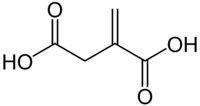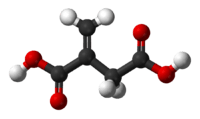Itaconic acid
 | |
 | |
| Names | |
|---|---|
| IUPAC name
2-Methylidenebutanedioic acid | |
| Other names
Methylenesuccinic acid;[1] 1-Propene-2-3-dicarboxylic acid | |
| Identifiers | |
| 97-65-4 | |
| ChEBI | CHEBI:30838 |
| ChEMBL | ChEMBL359159 |
| ChemSpider | 789 |
| Jmol interactive 3D | Image |
| KEGG | C00490 |
| PubChem | 811 |
| |
| |
| Properties | |
| C5H6O4 | |
| Molar mass | 130.10 g·mol−1 |
| Appearance | White crystals |
| Density | 1.63 g/cm3[1] |
| Melting point | 162 to 164 °C (324 to 327 °F; 435 to 437 K) (decomposes)[1] |
| 1 g/12 mL[1] | |
| Solubility in ethanol | 1 g/5 mL[1] |
| Except where otherwise noted, data are given for materials in their standard state (at 25 °C [77 °F], 100 kPa). | |
| | |
| Infobox references | |
Itaconic acid, or methylenesuccinic acid, is an organic compound. Itaconic acid is a white crystalline powder. Itaconic acid is a naturally occurring compound, non-toxic, and readily biodegradable. The name itaconic was devised as an anagram of aconitic.
Historically, itaconic acid was obtained by the distillation of citric acid. Since the 1960s, it is produced industrially by the fermentation of carbohydrates such as glucose using Aspergillus terreus. As such, it is a fully sustainable industrial building block. It is primarily used as a co-monomer in the production of acrylonitrile-butadiene-styrene and acrylate latexes with applications in the paper and architectural coating industry.
Itaconic acid is produced in cells of macrophage lineage and as such it has in vitro activity against bacteria expressing the enzyme isocitrate lyase such as Salmonella enterica and Mycobacterium tuberculosis.[2]
However, cells of macrophage lineage have to "pay the price" for making itaconate, and they lose the ability to perform mitochondrial substrate-level phosphorylation,[3]
References
- 1 2 3 4 5 Merck Index, 11th Edition, 5130
- ↑ Michelucci, A.; Cordes, T.; Ghelfi, J.; Pailot, A.; Reiling, N.; Goldmann, O.; Binz, T.; Wegner, A.; Tallam, A.; Rausell, A.; Buttini, M.; Linster, C. L.; Medina, E.; Balling, R.; Hiller, K. (2013). "Immune-responsive gene 1 protein links metabolism to immunity by catalyzing itaconic acid production". Proceedings of the National Academy of Sciences 110 (19): 7820–5. Bibcode:2013PNAS..110.7820M. doi:10.1073/pnas.1218599110. PMC 3651434. PMID 23610393.
- ↑ Nemeth, B.; Doczi, J.; Csete, D.; Kacso, G.; Ravasz, D.; Adams, D.; Kiss, G.; Nagy, A. M.; Horvath, G.; Tretter, L.; Mocsai, A.; Csepanyi-Komi, R.; Iordanov, I.; Adam-Vizi, V.; Chinopoulos, C. (2015). "Abolition of mitochondrial substrate-level phosphorylation by itaconic acid produced by LPS-induced Irg1 expression in cells of murine macrophage lineage". The FASEB Journal. doi:10.1096/fj.15-279398. PMID 26358042.
|